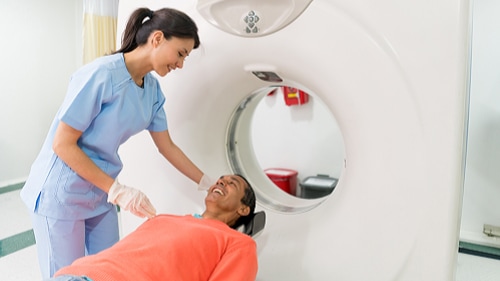At a glance
Radiation and radioactive materials are used every day in medical settings to improve health outcomes. While additional exposure to radiation can be harmful to human health in certain doses, the benefits of diagnosing or treating health problems with ionizing radiation usually outweigh the risks involved. Make sure to tell your doctor if you are or think you could be pregnant before procedures that involve radiation.

The basics
High doses of ionizing radiation can be harmful to human health. However, radiation and radioactive materials are used every day in medical settings to improve health outcomes and even save lives.
Radiation is used in many medical imaging procedures. Medical imaging procedures deliver x-ray beams, a form of ionizing radiation, to a specific part of the body. They create a digital image or film that shows the structures inside that area like bones, tissues, and organs. Healthcare providers can use these images for diagnostics, finding out what is causing your health problem, or sometimes to guide treatment.
Imaging procedures are usually performed in radiology or imaging centers in hospitals or clinics by a radiologist. Radiologists are medical professionals who are trained and certified to conduct imaging studies with radiation.
Medical radiation practices and equipment are regulated by state and federal programs to ensure safety.
Impacts
There are possible short-term and long-term risks from the very low doses of radiation exposure from imaging procedures. Ionizing radiation can damage cell DNA, but in the low amounts used in each imaging procedure cells can normally repair themselves. When cells get too much radiation over time, this damage can lead to cancer.
Exposure to ionized radiation beyond daily exposures, including from imaging procedures, slightly increases the risk of developing cancer later in life.
Usually, the benefits of diagnosing or treating health problems with ionizing radiation will outweigh these risks. These procedures only deliver radiation to the area that needs imaging, protecting all other parts of the body. Procedures should always use the lowest amount of radiation needed to create a good quality image. This process is referred to as "as low as reasonably achievable" (ALARA).
Find more specific information on these common imaging procedures:
- Radiography (x-rays) and dental x-rays
- Mammography
- DEXA Scans (bone density)
- CT scans (computed tomography scans)
- Fluoroscopy
- Nuclear medicine
Find information on special considerations pregnant women and children.
Talk to your healthcare provider and radiologist about the specific benefits and risks of the procedure recommended for your specific situation. These are some of the general benefits and risks for imaging that uses radiation:
Benefits
Risks
Prevention
The best way to make sure you are not getting more exposure to radiation than necessary is to keep track of imaging procedures and make sure each healthcare provider or specialist you see receives your results. This includes sending previous imaging results to any new healthcare provider before your visit.
It is important to tell your healthcare provider and the radiologist if you are pregnant or think you could be pregnant.
To help reduce your exposure and to help decide what type of imaging or testing is best for you, consider asking your health care provider:
- Do any of my recent tests provide the imaging needed?
- Are there other tests that do not use radiation that can provide the needed information?
For your procedure, the radiologist will use the lowest amount of radiation needed. These doses are further reduced for children. During the procedure you will often receive a lead protective shield to prevent other areas of your body that don’t need imaging from being exposed to radiation.
Other medical radiation experts include the following:
- Hospital radiation safety officer
- Medical physicist
- Radiation physicist
- Diagnostic medical physicist
Imaging Procedures That Don’t Use Radiation
Some alternative imaging procedures that do not use ionizing radiation include Magnetic Resonance Imaging (MRI) and ultrasound.
MRI procedures use magnetic fields and radio waves to produce images of specific parts of the body. Ultrasound imaging uses high-frequency sound waves to see inside the body.
You and your healthcare provider will select the best type of imaging procedure for your situation and make sure the potential benefits to your health outweigh possible risks from the procedure.
